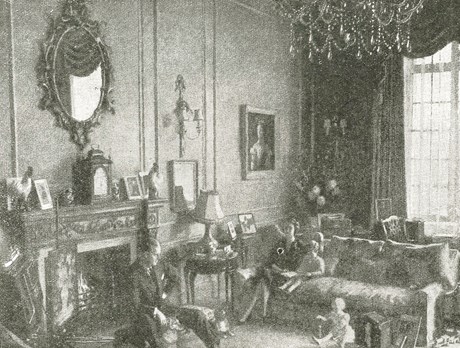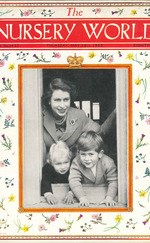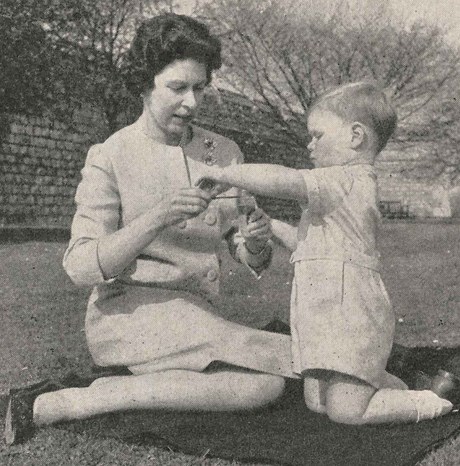Nursery World 90th anniversary: Monarchy - Inside the royal nursery
Hannah Crown
Monday, December 14, 2015
Prince Charles banging a drum, Princess Anne’s independence, Prince Andrew’s gilt wickerwork cot… such telling royal insights appeared in scintillating detail, finds Hannah Crown

In its earliest incarnations, Nursery World provided a fascinating glimpse into royal history, charting the birth of the Queen through to intricate details of the nursery play of royal children across the world.
‘I’ve had the good fortune to see Queen Mary on several occasions lately while she has been visiting homes and hospitals in which there are wee children, and it is amazing to see how the small folk “take to her”, as the nurses put it. They seem to know instinctively that she is inspired by a very real love of the weak and helpless. Certainly she is at her best and most gracious at these times.’ This extract, from 24 March 1926, about the Queen’s grandmother, is a fairly typical example of the glowing tones used to describe the monarchy in Nursery World in the early part of the century.
The Queen Mother’s courtship and the Queen’s arrival into the world, the year after the magazine was launched, were recounted on 28 April 1926 in the breathless language of hot celeb gossip: ‘The story of “Our Little Duchess” [The Queen Mother] has all the elements of romance. The youngest of a great Scottish family, she was hardly known to the great British public when her engagement to the Duke of York was announced, but in Society it was known that he had proposed to her twice and been refused, and that the Queen had written to her to say that she was on no account to “marry Bertie unless she felt she could be really happy with him”.
‘Queen Mary, though… disappointed that the Duchess of York preferred to have her Baby at home instead of at White Lodge or Buckingham Palace, is not a bit disturbed because the first baby is a girl. The fact that the wee one is in the direct succession to the throne was emphasised by the fact that the Home Secretary was summoned to Bruton St… Without any request, taxi drivers avoided Bruton Street the morning after the arrival for fear of disturbing the Duchess.’It was not just British monarchy who caught Nursery World’s attention, or indeed gave their attention to the magazine. On 14 April, the editor wrote that the Queen of Serbia has become a subscriber. Those glowing tones again: ‘Now, by the kindness of Her Majesty, who is, you know, a daughter of the beautiful Queen of Rumania, and therefore a second cousin to our own King George, we are able to give you many interesting details of the way HRH Prince Peter, Crown Prince of Serbia, spends his time…. “Peterkins” has an English nurse, of course. She is not college trained, but was sent by the Queen to All Saints’ Training College, Harrogate, for a time to learn all the most up-to-date methods of dealing with babies. The Queen… fed [Prince Peter] herself for six months…since then he has been fed on the Truby-King method. His first birthday was spent in England, at Harrogate, and he was taken to All Saints’ on that occasion and shared his birthday cake with the nurses there.’

A painting depicts the Queen, Duke of Edinburgh, Prince Charles and Princess Anne at Clarence House (28 May 1953), below
Major milestones such as the coronation garnered fascinating glimpses into the childcare at Buckingham Palace. On 28 May 1953, a piece on ‘The Royal Children’ reads: ‘Years ago the Palace nurseries were always governed by strictest etiquette. Even the maids at their work had to rise and curtsey respectfully if the Royal infant went past in the bassinette, and footmen served the meals as ceremoniously as they did the Sovereign’s own dinner. But in these happier democratic days, the pleasant second-floor rooms at Buckingham Palace  where the Queen’s children live are just like any other nursery. Prince Charles, who will be five next November, and Princess Anne, three years old in August, are being brought up on modern lines without any undue fuss or formality. It would not be correct to say they are “exactly like other children”. Prince Charles and sister are already being taught to wave and smile back to the crowds who greet them… But apart from learning such courtesies, the Queen’s children have a simple, quiet daily routine under the direction of their nannie. The Queen likes to visit the nurseries at least once every day… If the Queen has a little free time immediately before lunch, she goes out into the Palace gardens to play with the children, and the hour after tea is always preserved for them whenever possible.
where the Queen’s children live are just like any other nursery. Prince Charles, who will be five next November, and Princess Anne, three years old in August, are being brought up on modern lines without any undue fuss or formality. It would not be correct to say they are “exactly like other children”. Prince Charles and sister are already being taught to wave and smile back to the crowds who greet them… But apart from learning such courtesies, the Queen’s children have a simple, quiet daily routine under the direction of their nannie. The Queen likes to visit the nurseries at least once every day… If the Queen has a little free time immediately before lunch, she goes out into the Palace gardens to play with the children, and the hour after tea is always preserved for them whenever possible.
‘Prince Charles and Princess Anne come to the Queen’s sitting room and there are merry games of railways… or horses or maybe tossing balls with Mummy and Papa. Prince Charles is a sturdy, active boy with an extremely inquiring mind and marked intelligence. He has the Queen’s thick, dark golden hair and sea-blue eyes, but his features and many of his mannerisms are like those of the Duke of Edinburgh. Princess Anne has her father’s lighter flaxen hair, and is a gay quicksilver child of considerable independence of character. She prefers to dress and undress herself and is apt to resent it when her brother tries to “help” with her games. She does not entirely share Prince Charles’s affection for noisy occupations either. He loves to “play a tune” on his trumpet or thump his drum energetically or to stand and recite aloud. He is also fond of the telephone, which he now knows how to use reasonably well. Owing to the size of Buckingham Palace, the telephone has to be used for inter-communication. Looking at the television is a treat, not a daily occurrence, for the Queen’s children, since they are always encouraged to amuse themselves rather than have ready-made entertainments… The Queen herself has taught her son the elements of the three Rs.’
On 10 March 1960, in a feature on the birth of Prince Andrew the previous month, we learned that ‘the little Prince sleeps in the gilt wickerwork cot which has held three generations of royal children… draped with white spotted nylon net and lined with white satin appliqued with pale blue bows. The new satin quilt was reversible, pink one side and blue the other.’ The birth of Princess Anne also prompted a flurry of coverage, including an article on historic ‘Annes’ and later features on her 11th and 21st birthdays.

Prince Andrew was the star of the 27 September 1962 issue
There are brief mentions during the 1980s – the wedding of Charles and Diana in 1981 and a royal wedding route game, and then in 1988, when the tone became decidedly less reverential. In the 25 February edition the then editor wrote, ‘When I was a child I remember being enthralled by “Crawfie’s” column in [Woman’s Own]. Crawfie, for those too young to know, was governess cum nanny to the Queen and Princess Margaret for 17 years. I found her stories about the ‘little princesses’ fascinating but, unfortunately, the Royal Family was not amused. They have never forgiven her for what they considered her indiscretion, although her disclosures about life in the Royal household seem incredibly mild in comparison with the gossip in the tabloid newspapers these days. However, the breach between Crawfie and her eminent charges was never healed and when, sadly, she died last week the Royal Family allowed her death to go unacknowledged. Strange, perhaps, when one thinks how important she must have been in our monarch’s formative years.’
Royal coverage peters out from the 1990s onwards, following the adoption of the magazine’s professional focus. The birth of Prince George and Princess Charlotte has hitherto been unmentioned.




